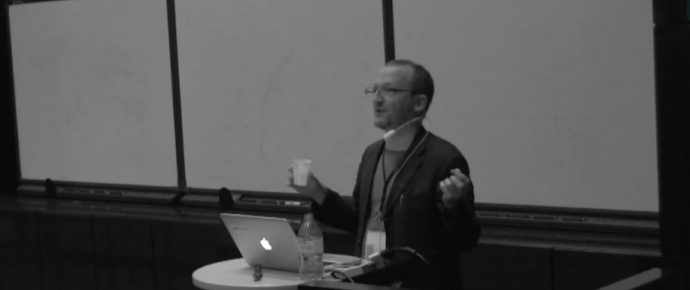Watch Stephen Graham’s keynote, Super-tall and ultra-deep
Stephen Graham, Professor of Cities and Society at Newcastle University, expanded the notion of mobility in his keynote talk at the Networked Urban Mobilities conference. By thinking critically about the politics of elevators Graham shifted the perspective from horizontal mobility to the verticality of urban life. Further, the talk links the skyscrapers of global cities with the gold mining industry, which continue to extract metals at greater and greater depths.
After his keynote we had a brief chat with Stephen Graham about his experience of the Networked Urban Mobilities conference, which you can read below the video.
After his talk at the Networked Urban Mobilities Conference in November 2014, we sat down with Stephen Graham and asked a few questions about his experience of the Cosmobilities event in Copenhagen.
Oskar Funk: Could you tell a little about what you are going to take with you from this conference?
Well, there has been a lot of great presentations on the challenges of innovation. That has been a big thing for me. The really complex ways of both inhibiting old technologies and the attempt to build new systems into systems, not just little pockets of innovation, as John Urry was talking about in his keynote, within the context of peak oil, peak food, peak water, and a century of enormous challenges.
Oskar Funk: What has been the best experience at the conference, or was there an experience that stood out?
I haven’t been to many of these mobilities conferences since the first one in Lancaster. The surprising and really fantastic thing to me is just the scale and variety in debate. The fact that it has become such a hugely important and influential conference series is really impressive.
Oskar Funk: So what do you see as the future for this network and this conference series?
There are challenges because it is very interdisciplinary, and it has challenging relationship with professionalized worlds of education and practice. Because obviously, both the disciplines of the universities and the disciplines of professional practices of engineering, architecture, civil engineering, IT engineering, they are all very much working in silos, and mobilities discussions are inherently multi-scalar, multi-disciplinary and they challenge all of those silos. Those silos are actually quite conservative, because they are protecting their own statuses and privileges. John Urry was talking to me about; how do you engage with the worlds of professional education, so that transport engineers stop thinking and talking like transport engineers? That’s a really big challenge and it raises the other question of people doing PhD’s in these interdisciplinary agendas and areas, important and fascinating though they are, they have to get jobs in universities that are very often still quite conservative, still organized as a series of silos; anthropology, sociology, geography, politics, engineering. It is very hard to challenge these really big inherited, conservative traditions.
Oskar Funk: So what do you think is the directions for the mobilities paradigm?
You know what I am going to say. (Laughs) Well, I mean, I would say this obviously, since I am doing a lot of work on looking at the vertical scale, but I do think that it is an interesting agenda that needs to be addressed. I am always interested in the absences in debates and how, when knowledge is constructed and emerges, by definition; areas of absence are created as well, because they are not thought as relevant, they are not actually discussed. They are sort of there in plain sight, hidden in plain sight. I do think in a whole lot of debates about social sciences, geography, politics of space, mobility, we need to be more three-dimensional in our discussions.
Oskar Funk: So that is a blind-spot of the mobilities studies?
Yes, I think so. There is a big discussion on aeromobilities, aircraft mobilities, there is a smaller discussion on elite helicopter mobilities, but I would say, you know, the elevator. It’s fascinating why it is so completely neglected as a mobilities system. It’s an interesting thing to try to understand, and in geography it is partly a result of this flat two-dimensional treatment of urban space that has come through cartographic traditions especially.

